Whilst we are still in the chillier months of the year, let us take a look at an introduction to wetsuits.
There are plenty of wetsuits available on the market and lots of good advice going around. So if you’re looking to get a wetsuit, then do some research to make sure you’re getting what you need.

What is a wetsuit?
A wetsuit is a sort of ‘second skin’ if you like. You would wear one when you are either intending or likely to go into the water. It insulates the wearer and helps them to retain body heat. We will go into more detail in the next section on how they work.
They are often worn by people such as surfers, swimmers and paddlers to help keep them warm in the water.
A wetsuit helps to avoid hypothermia (a dangerously low body temperature) allowing them to carry out their activities for longer. Wetsuits won’t completely protect you from hypothermia and you may still get the chills from the initial contact with water.
How does a wetsuit work?
Wetsuits are made of a type of rubber called neoprene. This provides good insulation from the cold and is also quite buoyant which is handy for being in the water.
A wetsuit works by trapping a thin layer of water inside the suit, that your body warms up. Therefore you want the wetsuit to fit properly, let’s look at this in a minute.
Useful tip, you are always warmer when dry. So if you wear a wetsuit whilst paddling for example, and don’t intend to get wet, then combined with a set of waterproofs makes a good warm combination.
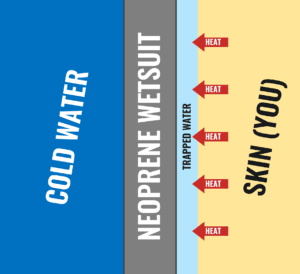
What size wetsuit do I need?
Wetsuits are typically based on normal clothing sizes, although there is some variation between brands.
Sizing Systems:
- Children’s wetsuits sized by age
- Men’s using the small, medium, large system
- Women’s using the number system (i.e. 8, 10, 12, 14, etc.)
Some reputable wetsuit companies will even do additional sizes such as tall and short, to suit those that are shorter or taller than average. For example you can get some which are ‘small tall’ or ‘large short’.

How do I get a good fitting wetsuit?
As always with clothing items, it’s best to go and try it on before you buy. This will also allow you to be able to try different variations and versions to see what suits you best.
When you try on a wetsuit, especially for the first time, it may seem like it’s maybe a tad tight. This is normal for a wetsuit, bear with I’ll explain.
Remember that a wetsuit works by trapping a thin layer of water inside the suit to help keep you warm. Neoprene loosens when wet, so when you get into the water the suit will loosen off ever so slightly. So it would be wise for it to have a snug fit when its dry.
A wetsuit is a sort of second skin, so should fit like so. There shouldn’t be any sagging or excessive bunching in places like the back, arms or legs. This is in places where the suit doesn’t have contact with your skin. It can create cold spots in the suit, giving you the chills.
A properly fitting wetsuit should only keep that initial thin layer of water inside the suit. Allowing your body to heat up that bit of water and keep you warm.
Ankle, wrist and neck seals should also have a good fit. This will prevent cold flushes of water entering your suit when moving around in the water.
What are the different types of wetsuit?
There are quite a lot of wetsuit variations and ones with different features.
Full suit – a full suit in one piece with a zip usually at the back, but some have front zips or even zips across the body. They will have long legs and long sleeves.
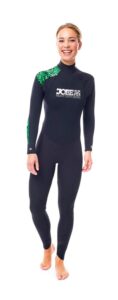
Shorty wetsuit – a shorty wetsuit is a t-shirt and shorts joined together made of neoprene, again with versions that have back zips and some with front zips.
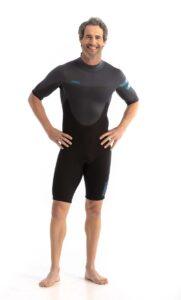
Long john – a long john is long in the legs like a pair of trousers with a vest style top joined to it, great if your bottom half spends a lot of time getting wet and your top half staying dry. When combined with a wetsuit top it makes for a versatile combination.
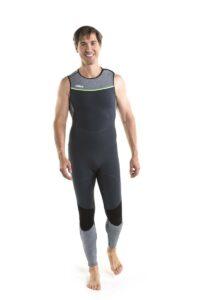
Shorty long john – a shorty long john is just like a normal long john but instead of having trouser style legs you get shorts. Perfect if you still want the wetsuit to protect your core areas but its too warm to be wearing a full wetsuit.
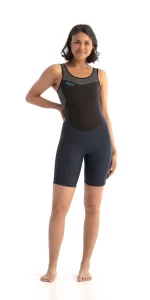
Top and trousers – a good combination if you struggle to wiggle your way into a full wetsuit so you can put on one piece at a time. It also gives you the option to mix and match as you want. Common sizes are 3mm although can go as thin as 0.5mm. You can even get jacket style wetsuit tops with a zip for easy access.
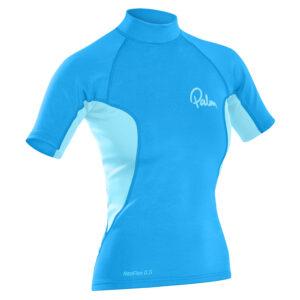
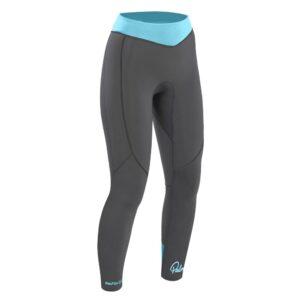
Shorts – a simple pair of skin-fitting shorts made of neoprene and may even come with a nice lining inside. Good paddling wetsuit shorts may even come with a higher back area to stop any drafts when you are sat down inside your boat.
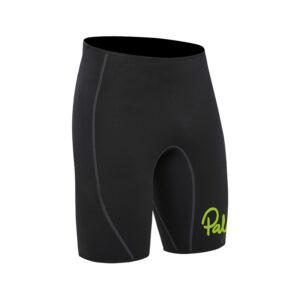
What do the thicknesses of wetsuits mean?
The thickness of a wetsuit’s neoprene is matched to the water temperature. There is nothing definitive although there is some suggestion on what’s right.
- 22°C (water temp.) is ideal for a UV rash guard, so you don’t overheat.
- 19°C to 22°C (water temp.) is good for a 2mm wetsuit, a shorty wetsuit would be ideal for this.
- 15°C to 19°C (water temp.) will suit a 3mm wetsuit, a full suit being best in this case.
Getting colder and colder, 4, 5 and 6mm wetsuits are for those who brave cold at the lower water temperatures. It is also a good idea to wear other neoprene items like a cap, gloves and boots at this point.

3mm wetsuits are widely used as they are the most versatile thickness. Most people will buy a 3mm wetsuit. This will do them for the summer and the warmer days before and after. A UV Rash Guard is good for the really hot days.
Wetsuits may have thinner material in the areas where you require ease of movement like in the arm, elbows, knees, etc.
What to do I wear underneath a wetsuit?
Wetsuits have a reputation for being difficult to get on and take off.
It’s personal preference whether or not you decide to wear anything underneath your wetsuit. Some people prefer to ‘go commando’ and not wear anything underneath their wetsuit. Feeling the pleasure of wearing a wetsuit, but it is also great for warmer water and locations.
Wearing a skin-tight undergarment underneath the wetsuit can help with getting it on and off, and is also more hygienic. Some may experience rashes or chaffing when wearing a wetsuit for a long period of time. So, an undergarment may be wise to wear to prevent this.
You can wear something such a swimsuit including Aquashorts and bikinis, a thin rash guard top or suit for example underneath a wetsuit. However, don’t wear anything loose fitting underneath like boardshorts in the wetsuit as it can bunch up and become uncomfortable.
Here is a couple more benefits for undergarments:
- It gives you some coverage when getting changed, so that you don’t go flashing other people.
- It also gives another layer for warmth and insulation in those ‘special’ areas.
- Maybe also some more comfort depending on your undergarment preference.

How do I care for my wetsuit?
Looking after your wetsuit will prolong it’s life and make it nicer for longer. Store your wetsuit in a wardrobe for example away from direct sunlight and major temperature changes. Avoid creases and damage to your wetsuit by storing it on a wide hangar and not keeping it pressed up against anything else which could put indents into it.
Avoid folding it as this will put creases in it and can weaken certain areas. Store in flat underneath your bed is another good way to store it.
When you are finished with your wetsuit, wash it down with clean water afterwards. Even if you didn’t go for a dip. This helps remove dirt and contaminants, as well as sweat absorbed by the suit. There are special wetsuit detergents available to help preserve and maintain the material.
Dry your wetsuit inside out at first, then when its dried turn it out so it’s the normal way round, and hang to dry until its completely dry and ready for storage.
If you have used your wetsuit in salt water, lubricate the zip so it doesn’t get stuck the next time you use it.
Are there any other wetsuit products?
There are certainly other wetsuit products that may be useful to have, especially in colder weathers.
Neoprene gloves – neoprene gloves are usually 3mm thick and work the same way as a wetsuit, they can give you better grip and also warm up your cold fingers which can easily become stiff and limited in movement.
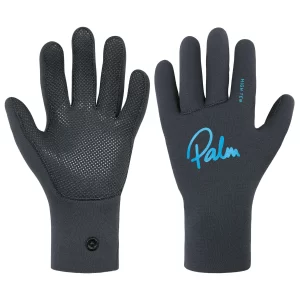
Neoprene socks – neoprene socks help to keep your feet warm, they can also add to comfort. They are worn underneath wet shoes and boots. However, you might want the next size up wet shoes or boots for a good fit.
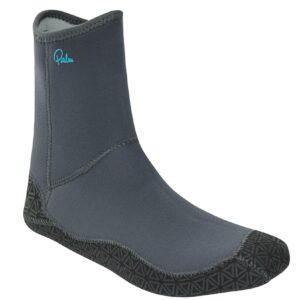
Neoprene hoods and caps – differing slightly from swim caps, neoprene hoods and caps are very effective at keeping your head insulated which in turn, helps to regulate your body temperature. It will also protect your head from the wind chill when you are in and out of the water.
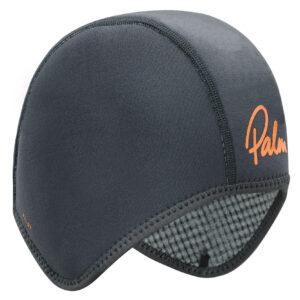
Wet shoes and boots – these are definitely a must have. They can be worn with pretty much everything from a full wetsuit to a UV rash guard. They protect your feet from cuts and grazes and also have good grip for generally walking or going across rocks to get to the water.
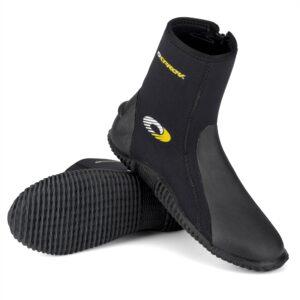
If you have any questions or need recommendations and advice, then feel free to get in touch with us here at Canoe2 by emailing [email protected] or connecting with us on social media.
You could even pop into The Paddleboard Shop here at Rushden Lakes to have a chat, or come and visit us online at https://shop.canoe2.co.uk/
We are in The Boathouse, Boardwalk, Rushden Lakes, Northamptonshire, NN10 6FA.
